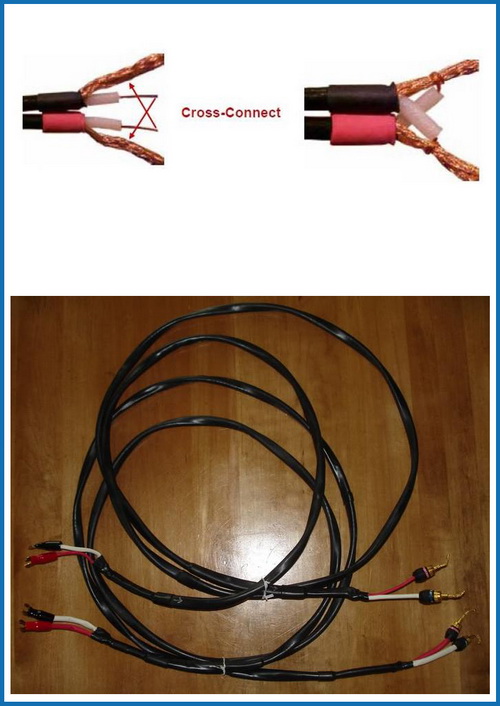AudioReputation is reader-supported. When you buy through links on our site, we may earn an affiliate commission Learn More
Coaxial cables are quite common these days, and you can find them in every home. They are used for the transmission of audio and video signals, for TV antennas, modems, cable boxes, and they can even be used as speaker cables. If you want to learn more about coax cables, you’ve come to the right place. In this article, we will give you an in-depth analysis of the physical and electrical characteristics of coaxial cables, talk about different types of coax cables, and list various use scenarios. We will also discuss the idea of using coaxial cables as speaker wire and analyze the pros and cons of coax speaker cables.
Table of Contents
- What is Coaxial Cable?
- What Does It Look Like?
- What are The Advantages and Disadvantages of Coaxial Cables?
- Different Types of Coaxial Cables
- What Kinds of Connectors Are Used for Coax Cables?
- What is Coaxial Cable Used For?
- What is Coaxial Digital Audio Cable?
- Digital Optical (TOSLINK) VS Coaxial Digital Audio Cable?
- Can Coaxial Cable Be Used as Speaker Cable?
- How to Convert A Coax Into A Speaker Cable?
- Advantages and Disadvantages of Coaxial Speaker Cable
- Is Coaxial Speaker Cable Worth It?
- Can I Make a Coaxial Speaker Cable on My Own?
- FAQs
What is Coaxial Cable?
Coax cable is a type of electrical cable that can transmit RF signals from source devices to input/destination devices. The radiofrequency range (RF range) spans from the upper end of the audio spectrum to the lower end of the infrared spectrum (from 20kHz to 300GHz).
The term ‘coaxial’ refers to the construction of the cable – this term is used because the core of the cable (the inner conductor) and the woven shielding (usually made of copper) share the same axis (they are coaxial).
The cable was first used in 1858, but it was patented 22 years later, in 1880. Since the beginning of the 20th century, and especially since the introduction of television, it’s one of the most common cables in every household.
What Does It Look Like?
Coaxial cables have a simple cylindrical shape. Their thickness and color may vary, and their structure may be more or less complex, but every coaxial cable has 4 key elements. Those four elements are:
- Core conductor
- Dielectric insulator
- Metallic shield (usually woven copper)
- Plastic jacket

Structure of a coaxial cable
Copper is usually used for the core. Copper-plated steel and stranded copper are also commonly used.
The core conductor is surrounded by a dielectric insulator. This insulator can be made of solid plastic, or foam plastic, or air with spacers.
In most cases, braided copper wire is used for the shield. In some cases, it’s a silver-plated braid. Higher-quality cables may have two shields – aluminum foil combined with a braided copper wire. Sometimes, there’re even four layers of shielding – two layers of aluminum foil and two layers of braided copper wire. Improved shielding prevents losses and improves performance, but it also makes the cable thicker and less flexible, which is not always desirable.
The final layer is commonly known as the jacket, and it’s usually made of PVC (Polyvinyl Chloride). Depending on the purpose, the jacket can also be made of some fire-resistant material, a material resistant to oxidation and ultra-violet light, or water-resistant material.
What are The Advantages and Disadvantages of Coaxial Cables?
There must be a reason why coaxial cables are so commonly used, especially in radio communications, telecommunications, wi-fi systems, cable TV, and cable modems. In fact, there’re a few reasons.
The most important advantage comes from the specific design and construction of a coaxial cable. Thanks to such a great shielding and outer jacket, coax cables are less susceptible to electromagnetic and radio-frequency interference. Another advantage of coax cable construction is that enables high-frequency applications (50 MHz and higher). Finally, compared to twisted pair cables, coax cable enables higher bandwidth transmission and higher transfer rates. Coaxial cables are also fairly affordable, easy to install and expand, and quite durable.
The disadvantages of coax cable are not huge. The biggest problem is that only one cable is used for transmission across the network and, if that cable fails/breaks, the whole network collapses.
| Advantages | Disadvantages |
|---|---|
| Affordable | One cable failure brings the entire network down |
| Easy to install and expand | Has to be grounded |
| Durable | It can be thick and stiff, which makes the installation much harder |
| Resistant to EMI and RFI | |
| Enables high-frequency applications | |
| High-bandwidth transmission | |
| High transfer rates |
Different Types of Coaxial Cables
You can make a difference between coaxial cables based on their impedance, on their thickness and construction, on their purpose, on the dielectric type, on the type of connectors they end with, etc.
When it comes to impedance, you can make a difference between two main types – those with 50Ω impedance and those with 75Ω impedance.
50Ω cables are commonly used for radio transmission applications because 50Ω is a good match for various transmitter antennas and radio transmitters. These cables are also used for coaxial Ethernet networks, and for high-frequency digital transmissions.
Recommended Reading :
- Can You Use HDMI and Optical Audio at the Same Time?
- How to Connect a Soundbar to TV with an Optical Cable?
- USB Cable Types Explained
75Ω cables are much more common in our households. If you have a coaxial cable in your home, there’s a great chance it’s a 75Ω cable. They are often used for video/audio transmission and in telecommunications. RF video transmission and cable TV systems are also based on the use of 75Ω coaxial cables.
There’re also cables with 52Ω impedance, 93Ω impedance, and other impedances, but they are far less common.
RG (Radio Guide) standard was used since WWII for the classification of coaxial cables. This standard is obsolete, but it’s still widely used. These two letters (RG) are followed by a number and sometimes a letter. Based on the RG classification, you will know all the important characteristics of the cable – diameter of the core wire, outer diameter, impedance, dielectric type and diameter, shielding. Most importantly, based on the RG code, you will know what kind of connector you have to use.
Below, you can find a list of the most common types of coax cable and their characteristics.
| Cable Type | Core diameter | Outer diameter | Impedance | Use |
|---|---|---|---|---|
| RG-6/U | 1.024mm | 6.86mm | 75Ω | Cable TV, satellite TV, cable modems |
| RG-6/UQ | 1.024mm | 7.57mm | 75Ω | Same as RG-6/U but with better shielding |
| RG-7 | 1.3mm | 8.13mm | 75Ω | Same as RG-6/U |
| RG-8/U | 2.17mm | 10.3mm | 50Ω | Amateur radio |
| RG-8/X | 1.47mm | 6.1mm | 50Ω | Same as RG-8/U |
| RG-11/U | 1.63mm | 10.5mm | 75Ω | Same as RG-7 but with lower losses |
| RG-58/U | 0.81mm | 5mm | 50Ω | Amateur radio, radio communications, Ethernet |
| RG-59/U | 0.64mm | 6.1mm | 75Ω | HQ HD video signal transmission over short distances |
| RG-60/U | 1.024mm | 10.8mm | 50Ω | HD cable TV High-speed cable internet |
Naturally, you won’t have to measure the cable to identify the kind of connector you need – you just have to look at the specification. In most cases, you will find the RG label written on the cable itself.
What Kinds of Connectors Are Used for Coax Cables?
Different kinds of cable and different applications require different connectors. Coax cables are used with a number of different connectors, but the most common types are BNC, N-type connectors, SMA connectors, F-type connectors, and RCA connectors.

The most common coax cable connectors
BNC connectors are used for RF and video applications. It is designed for frequencies up to 10 GHz (stable up to 4 GHz – after that it may radiate signal, and the losses increase).
N-type connectors are designed for use with lower microwave frequencies up to 18 GHz. It’s used for various RF applications (communications and broadcast equipment).
SMA connectors are frequently used connectors for RF applications. Originally, the SMA connector was designed to work with frequencies ranging from 0 Hz to 12 GHz. Today’s SMA connectors can work with frequencies up to 24 GHz. SMA connectors are used in hand-held radio antennas, mobile telephone antennas, microwave systems, wi-fi antenna systems, etc.
F-type connectors are, by far, the most common connector type for coaxial cables, because it’s used for TV cables and antenna cables. F-type connectors can handle frequencies up to 1 GHz
RCA connectors are also commonly used with coaxial cables, usually for audio and video transmission. They can handle frequencies up to 10MHz.
What is Coaxial Cable Used For?
Coaxial cables are used for various applications in radiocommunication systems, telecommunication systems, wi-fi systems. They are used for TV antennas, HD TV, cable TV, cable internet, audio and video transmission, etc.
Different cable types and different connectors are used for different applications. The most popular cable types (like RG-6, RG-7, RG-11, RG-60) and most popular connector types (F-type connector) are used for cable TV, high-speed cable internet, and satellite TV.
50Ω coax cables (like RG-8, RG-58) are used for radio applications
What is Coaxial Digital Audio Cable?
One of the common coax cable applications is related to audio signal transmission. For the purposes of audio transmission, we use the so-called coaxial digital audio cable. It’s a regular 75Ω coax cable we’ve already talked about (it could be AWG 18 like RG-6) with RCA connectors.
Visually, they look exactly like analog RCA cables, but they are designed to transmit the wide-frequency bandwidth of a digital signal. Also, the difference is that you need one coax audio cable to transmit the entire signal. With analog RCA cables, you need two (left and right). Also, digital coax cables have 75Ω impedance, while analog RCA cables usually have 50Ω impedance.

Digital coaxial audio cable and digital coaxial audio input
Coaxial audio cable supports uncompressed 2ch PCM audio, as well as DTS and Dolby Digital up to 5.1.
Other multi-channel Dolby and DTS audio formats (Dolby Digital Plus, Dolby Atmos, DTS:X, etc.) are not supported. Also, uncompressed multichannel audio is not supported.
Digital Optical (TOSLINK) VS Coaxial Digital Audio Cable?
The optical connection is maybe more common when it comes to digital audio, but many devices have both – optical and coaxial. So, is there a difference between the two?
Well, first of all, there’s the obvious difference – they look completely different. The connectors are different, the structure of the cable is different, and the working principles are different.
Optical cable has optical fibers (not solid copper core) that transmit light and not electrical signals. The cable transmits light pulses that go between the source device and destination device.

Aside from the obvious, there’re some more important performance and durability-related differences.
The coaxial cable enables slightly greater bandwidth and allows transmission of higher-quality audio (24bit/192kHz VS 96kHz). Theoretically, that should mean better listening experience but, to be honest, most people won’t hear the difference
The optical cable is a good choice for shorter distances (up to 5m/15ft), while coaxial cables can be used over much longer distances. Optical cables are also less durable than coaxial – simple bending could damage your optical TOSLINK cable.
Can Coaxial Cable Be Used as Speaker Cable?
As you’ve seen, coax cable has many applications. One of them is the transmission of digital audio signals. But can you use coax cable to send a signal from an amp to speakers? In other words – can you use it as a speaker wire? And are there some benefits? Is coaxial cable going to introduce less resistance between your amp and your speakers?
Before we start answering all the questions, we want to point out one more thing. RCA coaxial cables are not so uncommon when it comes to wiring external powered subwoofers. Most of today’s RCA subwoofer cables use RG-6 coax cable. So, a digital coax cable can easily transmit line-level audio signals to the subwoofer, and there will be no issues of any kind. But what about the speaker-level signal? Can you use it as a speaker wire?
The short answer is YES. You can use a coaxial cable as a speaker wire. Some manufacturers even make and sell coaxial speaker cables. For example, the manufacturer called WBC (World’s Best Cables) sells coaxial speaker cables on Amazon. Their cables use Mogami W3082 coaxial speaker wire (AWG14) and gold-plated banana plugs by Eminence.

WBC AWG14 coaxial speaker cable
Another very popular speaker cable is Jon Risch’s DIY cross-connected coax speaker cable based on Belden 89259 coax cable (which is RG-59/U coax cable). For each speaker, he used two cables. He cross-connected the shielding of one cable to the center conductor (core) of the other cable and vice versa.

Jon Risch’s DIY cross-connected coax speaker cable (source – DIY Audio Projects)
But why would you use a coaxial speaker cable instead of a regular speaker wire? Are there some advantages? And what about the disadvantages?
How to Convert A Coax Into A Speaker Cable?
If you want to convert a coax into a speaker cable, follow these steps:
Step 1: Use wire strippers and remove about an inch of the outer sheath of the coaxial cable. Now, you should see a braided wire and a central core wire.
Step 2: Gently separate the braided wire from the core wire.
Step 3: Cut the core wire to the desired length, and strip about a quarter inch of insulation from the end of the wire using wire strippers.
Step 4: Twist the braided wire together to create a single ground wire.
Step 5: Attach the signal wire to the positive terminal of your speaker and the braided wire to the negative terminal.
Step 6: After connecting the wires, test the sound quality to ensure the conversion has succeeded or not. Adjust the volume and EQ settings as needed to achieve the desired sound.
And that’s it. You just converted a coax into a speaker cable.
Advantages and Disadvantages of Coaxial Speaker Cable
The only advantage we could think of is related to the shielding and to coax cable’s resistance to interference. To find out more, we’ve had to consult the specialists. According to Mogami’s official website, the advantages of their coax speaker cable are:
- Thick conductor (almost 14AWG)
- Very low induction
- Suitable impedance for speaker wire
- Better sound quality than regular parallel speaker wire configuration
Note: Have in mind that these advantages apply only to Mogami’s coax speaker cable.
The disadvantages of using coax cables as speaker cables are more obvious:
- They are more expensive than regular speaker wire
- They are heavier and less flexible than regular speaker wire
- It takes longer to run and hide the speaker cable
- The capacitance of the cable is higher, which could result in some instability issues, especially when using long cables
Is Coaxial Speaker Cable Worth It?
So, even though you can use coax cable as speaker wire, is it worth it? Will you get any audible improvements if you use a coaxial speaker cable instead of a regular speaker wire?
In our experience, the difference between the two doesn’t really justify the price difference and all the hassle. So, we don’t think it’s worth it.
However, not everyone agrees with this statement. Some people argued that replacing their regular 14-gauge speaker wire with Mogami cables actually brought significant improvements to their stereo systems. The best advice we can give you is to try them and see if they work for you. After all, they are not crazy expensive (15ft of WBC coax speaker cable using Mogami coax speaker wire is priced around $115).
Can I Make a Coaxial Speaker Cable on My Own?
There’re numerous DIY tutorials explaining how to make coaxial speaker cable. Some are very detailed and fairly easy to follow. Others are short and confusing. The best explanation we’ve come across was the tutorial on how to make John Risch’s cross-connected coax speaker cable. As you already know, we don’t really think that making this exotic cable is worth all the hassle, but you can try to make it and see if you like the results.
Also Read: Component vs. Coaxial Speaker: Which One Is Better For You?
FAQs
Q: Can I Use Coax As A Subwoofer Cable?
A: Yes, coaxial cables can be used as subwoofer cables, but they may not provide the optimal performance that a dedicated subwoofer cable is capable of achieving. Coaxial cables have a wider frequency range than subwoofer cables, which could result in a loss of signal quality for low-frequency signals.
Q: Is Coax Good for Audio?
A: Yes, coaxial cables can be good for audio, especially in digital audio applications where they can transmit high-quality audio signals with low interference and signal loss. However, other factors such as the quality of the cable and connectors and the source and destination equipment, can also affect your audio performance.
So, there you have it. Now you have all the information about coax cables in general and about coax speaker cables. As always, we encourage our readers to share their thoughts and experiences with us. Do you like these cables? Have you ever tried them? Leave us a comment below and tell us what you think.

Hello, my name is James Longman.
I’m a writer and editor at AudioReputation. I disassembled my first portable AM/FM radio when I was only 8. At the age of 11, I burned the circuit board on my old boombox cassette player. I’m not going to explain how but it was reckless and stupid.
Since then, I have become much more careful around radios, boomboxes, and other audio devices (at least, I like to think so) but I have never lost the passion for audio equipment. Throughout 20 years of my professional career, I’ve been working for various audio equipment manufacturers and even started building speakers on my own in my little workshop.
I love the work we do here at AudioReputation. Testing, comparing, and evaluating all kinds of audio devices (speakers, soundbars, headphones, home theater systems, etc.) is something I truly enjoy. I try to be unbiased and give you my honest opinion on every piece of equipment I test. Still, you should take my reviews with a pinch of salt and always be just a little bit skeptical. The fact that I liked some speaker or soundbar doesn’t mean that you are going to love it. If you have the opportunity, you should test it/hear it before buying it.


About 12 years ago I built a home cinema, and ran wiring through the walls. But I only ran one pair of speaker wires to the front (all my components are in a closet in the back). Now I need two sets, to run height speakers for Dolby Atmos. I can’t re-wire now. I did however run coax cable to the front in the originaly set up. Can I use this for the height speakers? How would I?